I have various sizes of rectangles, and I am trying to fit them into a larger rectangle starting from the center. Below you will find an animation I created to visually describe what needs to take place.
I have been struggling to come up with a way to model this behavior. Does anything exist that is similar to this? I just need to be pointed in the right direction.

The following is a very rough explanation:
Initialize
- Start with
nrectangles - Order by density (they are really 3d cubes bird's eye view)
- Place first rectangle at center
Remaining rectangles (fit as many as I can) try to group highest density in the center and move outward
Dimensions = { width: 400, height: 300 }
Boundries = {
WEST = 0,
EAST = Dimensions.width,
NORTH = 0,
SOUTH = Dimensions.height
}
// each rectangle has width, height, and other information
rectArr = Array of {width:60, height:40}
root = { x:EAST/2, y:SOUTH/2 }
foreach rect in rectArr {
// I will always traverse from the root and try to go left and right. If I cannot, I move up and try the same thing. I then move down. The problem is if there are 5 or more rows. I will be starting from the root and going up, then down, then up-up, then down. It's like I have two parallel trees.
// Try to branch left or right
if rect.width <= (Boundries.EAST - ('rightmost rectangle'.x + 'rightmost rectangle'.width/2)) branch-right
if rect.width <= (('leftmost rectangle'.x + 'leftmost rectangle'.width/2) - Boundries.WEST) branch-left
// Try to branch up or down
if rect.height <= ((root.x + root.height/2) - Boundries.NORTH) branch-up
if rect.height <= (Boundries.SOUTH - (root.x + root.height/2)) branch-down
}